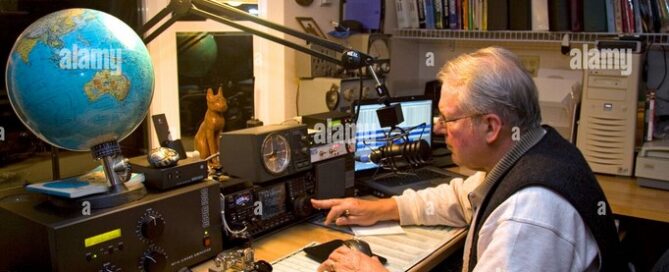
Amateur Radio
admin2025-02-23T17:31:03+06:00What is Amateur Radio
Amateur radio, also known as ham radio, is a popular hobby and service that brings people, electronics, and communication together. People use ham radio to talk across town, around the world, or even into space, all without the internet or cell phones. It’s a way for individuals to engage in non-commercial exchange of messages, wireless experimentation, self-training, private recreation, and emergency communication.
Amateur radio operators, or “hams,” can communicate with each other using various transmission modes, including voice, Morse code, digital data, and even television signals. To participate, individuals need to obtain a license, which requires passing an examination that tests knowledge of radio technology, operating practices, and regulations.
Amateur radio is not just a pastime; it has practical applications in emergency communications. During disasters, when other communication services might fail, amateur radio can provide vital links. Additionally, the hobby encourages experimentation and innovation in radio technology, contributing to advancements in the field.
Best Propagation Time
Understanding the best propagation times for different amateur radio bands can significantly enhance your communication experience. Here are some general guidelines:
- 160 meters (1.8–2 MHz): This band is typically best at night during the winter months, as it is more susceptible to noise and absorption during the day.
- 80 meters (3.5–4 MHz): Similar to the 160-meter band, 80 meters works best during nighttime, especially in the fall and winter when atmospheric noise is lower.
- 40 meters (7–7.3 MHz): This band is versatile, providing good propagation both day and night. It’s often used for long-distance communication in the evening and early morning.
- 20 meters (14–14.35 MHz): Known for its reliable long-distance communication, 20 meters is effective during the day, particularly in the late morning and early afternoon. It is also known for being open worldwide.
- 15 meters (21–21.45 MHz): This band shines during daylight hours and can provide excellent long-distance communication when the sunspot cycle is high.
- 10 meters (28–29.7 MHz): Best during the high points of the solar cycle, this band works well during daylight and can open up for long-distance contacts, especially in the late morning and afternoon.
These times are not absolute, as propagation can be influenced by various factors including the solar cycle, weather conditions, and geographical location. Regularly monitoring band conditions and using tools like propagation prediction software can provide more precise timing for your specific needs.
Amateur Radio Frequency in Bangladesh
In Bangladesh, the Bangladesh Telecommunication Regulatory Commission (BTRC) oversees the allocation and use of amateur radio frequencies. As of the latest available information, the following frequency bands are typically allocated for amateur radio use in Bangladesh:
-
160 meters band: 1.810 to 1.850 MHz
-
80 meters band: 3.500 to 3.800 MHz
-
40 meters band: 7.000 to 7.200 MHz
-
20 meters band: 14.000 to 14.350 MHz
-
15 meters band: 21.000 to 21.450 MHz
-
10 meters band: 28.000 to 29.700 MHz
-
6 meters band: 50.000 to 54.000 MHz
-
2 meters band: 144.000 to 148.000 MHz
-
70 centimeters band: 430.000 to 440.000 MHz
Please note that regulations and frequency allocations can change, so it is always wise for amateur radio operators to confirm the current frequency allocations with the BTRC
Select best Antenna
When it comes to selecting the best antenna for HF radio, there are several options to consider, each with its own advantages:
- Dipole Antenna: The dipole is a classic choice for HF radio enthusiasts. It’s simple, efficient, and offers a good balance between performance and cost. Dipoles can be easily adjusted for different frequencies and are well-suited for both short and long-distance communication.
- Vertical Antenna: Vertical antennas are popular for their low-angle radiation patterns, which are ideal for long-distance communication. They are also compact and can be installed in smaller spaces, making them suitable for those with limited room.
- Yagi-Uda Antenna: Known for their high gain and directional capabilities, Yagi antennas are excellent for HF radio operators looking to focus their transmission and reception in specific directions. They are often used in amateur radio contests and DXing.
- Loop Antenna: Loop antennas are favored for their ability to reduce noise and their compact design. They are effective for those in urban environments with limited space and high levels of RF noise.
- End-Fed Half-Wave Antenna: This antenna offers simplicity in installation and operation, as it requires only one support point. It’s a versatile option for portable and temporary setups.
For VHF/UHF radios, the following antennas are highly recommended:
- Quarter-Wave Ground Plane Antenna: This is a simple and efficient option that provides good omnidirectional coverage. It’s ideal for base stations and mobile setups.
- J-Pole Antenna: The J-Pole is a popular choice for VHF/UHF due to its simplicity and effectiveness. It offers omnidirectional coverage and is easy to build or purchase.
- Yagi Antenna: For those needing more range and directionality on VHF/UHF, a Yagi antenna is an excellent choice. It provides higher gain and is perfect for reaching distant repeaters or stations.
- Collinear Antenna: Known for their high gain and omnidirectional pattern, collinear antennas are ideal for base station use where maximum coverage is desired.
- Slim Jim Antenna: This antenna is a variant of the J-Pole and is known for its low profile and good performance. It is portable and easy to set up, making it a favorite for field operations.
Selecting the right antenna depends on your specific needs, including space constraints, budget, and the type of communication you intend to conduct.

